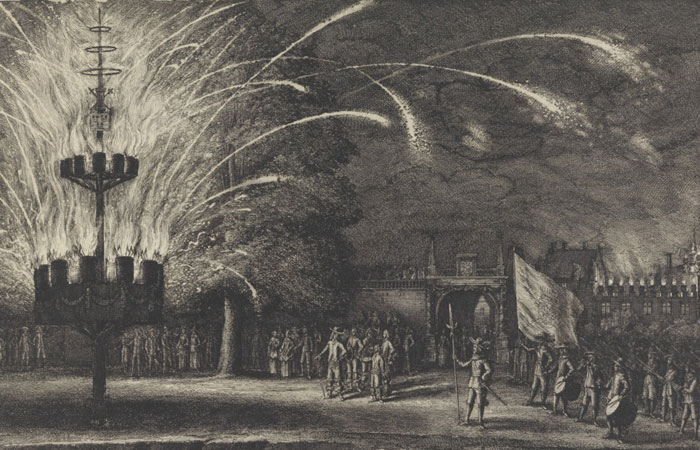This post is one in a series highlighting the special exhibition Nightfall: Prints of the Dark Hours, which explores evocative artistic images of night, called nocturnes. The exhibition is on view through March 22, 2016, in the VMFA Works on Paper Focus Gallery. Admission is free.

Wenceslaus Hollar (Bohemian, active in Germany, Flanders, and England, 1607–1677), Fireworks at the Hemissem, ca. 1650–51, etching, 9 7/16 x 15 7/8 in. Promised Gift of Frank Raysor
Many of the prints in Nightfall focus on responses to the psychological and metaphysical qualities of nighttime, but night also presents an enhanced opportunity for certain sensory experiences. Wenceslaus Hollar’s Fireworks at Hemissem (1650) depicts a fireworks display held for the Imperial Postmaster General of the Holy Roman Empire. Fireworks, their intrinsic value obvious to anyone who has ever seen them in person, allow for consideration of other ideas when documented or depicted in two-dimensional form.
The first, most obvious thing taking place in Fireworks at Hemissem is Hollar’s effort to evoke the experience of fireworks in some way that makes sense to the eye. This is a tricky undertaking as, if one were to try to depict fireworks as they really are, there would not be a great deal to see—a pyrotechnics display is a series of fleeting explosions. Thus, Hollar took certain liberties in order to communicate the idea that what is taking place in this image is dazzling. He treats the mortar rack like a candelabrum, wildly ablaze, with the trajectory of any single firework easily traceable from start to finish. This, along with his use of squiggles and pointy flames, conveys something of the experience of watching fireworks happen. This spectacle, paired with the placement of drummers, a trumpeter, several men with guns, and an enraptured crowd alongside it, creates a sense of noise, heat, and movement in open space, despite the image actually existing on a flat surface. This visual language is remarkably similar to that which one would employ today, despite the 365 years which have passed since this plate was etched.
The print also documents aspects of 17th-century European society. Wenceslaus Hollar was born in 1607 to a father who was a Bohemian yeoman/knight. This placed Hollar within a social stratum which allowed him to view and study art as one of Prague’s cultural elite and allowed him special opportunities. For example, Fireworks at Hemissem was made on Hollar and his wife’s visit to Hemissem, the home of Postmaster General of the Netherlands, Alexander Roelants. His decision to depict fireworks also indicates his status. Long before fireworks existed as the communal sort of spectacle set off at baseball games or on the Fourth of July, they existed in Europe as a symbol of political and socioeconomic power. Pyrotechnics held a tangible sense of elitism through combined elements of their extremely high price (fireworks at this time were essentially all manufactured in and exported from Asia), the property required for their display, and implications of war (e.g., bombs). With this in mind, the many fire-lit faces present in this print are there not because they happened upon the show, but because they, like Hollar, were of a privileged social group.
An image such as this makes clear how certain activities (and the social constructs behind them) morph over time. The explosions in the night sky illustrate the relatively permanent nature of the process of seeing and understanding a two-dimensional image. What is lit up by this scene, though, are certain socialized ideas (i.e. the organization of society and all that it entails) which seem absurd to the modern viewer. This all goes to show that cultural normalcy is just as constructed as the ability to decode an image is ingrained.
Bailey Goldsborough
Curatorial Intern,
VMFA Department of European Art